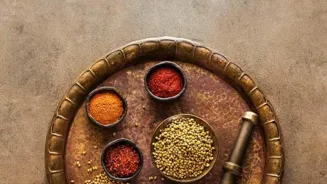Transform your veg biryani from bland to grand with these 10 tips! Learn the secrets to a culinary masterpiece
Biryani. Just the name itself conjures up images of fragrant rice, colourful veggies, and a flavour
bomb that explodes in your mouth. But let's face it, making a great veggie biryani at home can be tricky. Sometimes it ends up too dry, sometimes too mushy, and sometimes… well, just plain bland.
But fear not, biryani lovers! This guide will reveal 10 unmissable tips to transform your biryani from a kitchen mishap to a culinary masterpiece. We're talking about that perfect balance of spices, textures, and aromas that will have everyone reaching for seconds (and thirds!).
So, ditch the takeout menus and get ready to become the biryani king or queen of your household. These tips are suitable for beginners and seasoned cooks alike, and they cover everything from choosing the right rice to mastering the crucial dum cooking technique.
Get ready to unlock the secrets to a truly unforgettable vegetarian biryani experience.
Basmati rice key to perfect biryani; wash, soak, cook with care
The foundation of any great biryani is, of course, the rice. Don't even think about using just any old rice from your pantry. The best choice for biryani is long-grain basmati rice. Basmati rice has a delicate aroma, and most importantly, it doesn't become sticky when cooked.
Look for aged basmati rice if possible; it tends to cook up fluffier. Before cooking, it's essential to wash the rice thoroughly. Rinse it under cold running water until the water runs clear. This removes excess starch, which prevents the rice grains from sticking together.
After washing, soak the rice in water for at least 30 minutes, or even up to an hour. Soaking allows the rice to absorb moisture, which helps it cook evenly and become longer and more separate. This is a crucial step that many home cooks skip, but it truly makes a world of difference.
Think of it like hydrating before a marathon – the rice needs that extra moisture to achieve its full potential. Finally, when cooking the rice, use the correct water-to-rice ratio. Too much water will result in mushy rice, while too little will leave it undercooked.
A good rule of thumb is to use about 1.5 to 2 cups of water for every cup of basmati rice. However, this can vary slightly depending on your rice and cookware, so experiment to find what works best for you.
Make flavorful veg biryani by choosing, cutting, and marinating veggies wisely
Vegetable biryani is all about the veggies, so choose them wisely! The beauty of veg biryani lies in the variety of textures and flavors, so don't be afraid to experiment and use your favorites. Classic choices include potatoes, carrots, green beans, peas, cauliflower, and bell peppers.
You could also try adding mushrooms, paneer (Indian cheese), or even jackfruit for something a bit different. The key is to ensure that all the vegetables are cut into similar sizes so they cook evenly.
Nobody wants a biryani with some veggies that are perfectly cooked and others that are still rock hard! Pre-cooking some of the vegetables is also highly recommended, especially the ones that take longer to cook, like potatoes, carrots and cauliflower.
You can lightly saute them in a pan with a little oil or steam them until they are about halfway cooked. This will ensure that they are tender and not crunchy in the final biryani. Another trick is to marinate the vegetables in a mixture of yogurt, ginger-garlic paste, and spices before cooking.
This not only infuses them with flavor but also helps to tenderize them. A simple marinade of turmeric powder, red chilli powder, coriander powder, and a pinch of garam masala will also do the trick. Marinate for at least 30 minutes, or even longer if you have the time.
The longer the vegetables marinate, the more flavorful they will become.
Biryani masala: key spices, tips for making aromatic blend at home
The soul of any biryani lies in its masala, the aromatic blend of spices that gives it its unique flavour profile. While you can use pre-made biryani masala from the store, making your own blend is always a better option as you can control the ingredients and adjust the spice levels to your liking.
The core spices for a biryani masala typically include turmeric powder, red chilli powder (adjust to your heat preference!), coriander powder, cumin powder, garam masala, and a good dose of saffron. Some people also like to add black cardamom, mace, nutmeg, or star anise for extra depth of flavour.
Remember to roast the whole spices lightly before grinding them. This releases their essential oils and enhances their aroma. If using pre-ground spices, make sure they are fresh as old spices lose their potency. When making the masala, start by sautéing onions until they are golden brown.
This is a crucial step as caramelised onions add sweetness and depth to the biryani. Then, add ginger-garlic paste and sauté until the raw smell disappears. Next, add the dry spices and sauté for a minute or two until fragrant, being careful not to burn them.
You can add a little water to prevent the spices from sticking to the pan. Finally, add the pre-cooked or marinated vegetables to the masala and cook them until they are coated evenly.
Layering method infuses biryani ingredients for a flavorful dish
Layering is the heart of the biryani process. This critical method infuses all ingredients together, creating a single flavor. This is what truly separates biryani from a mere rice and vegetable dish! The order in which you layer the ingredients matters.
Generally, it's best to start with a layer of cooked rice at the bottom of the pot. This prevents the vegetables from sticking and burning. Next, add a layer of the vegetable masala, followed by another layer of rice.
Repeat these layers until all the ingredients are used up, ending with a final layer of rice. Between the layers, you can sprinkle fried onions, chopped coriander, and mint leaves. These add flavour and visual appeal. You can also drizzle a little saffron-infused milk or water over each layer.
Saffron imparts a beautiful colour and subtle flavour to the biryani. Adding a spoonful or two of ghee (clarified butter) between the layers also enhances the richness and aroma. Gently spread the ingredients to create as much surface area as possible.
This will assist with even flavor distribution, making each bite a blast of deliciousness.
Dum cooking: slow-cook biryani in sealed pot for rich flavors
Dum cooking is the technique of slow-cooking the biryani in a sealed pot, allowing the flavours to meld together and create a truly unforgettable aroma. The key is to seal the pot tightly so that no steam escapes. There are several ways to do this.
The most traditional method is to use dough to seal the lid of the pot. Simply make a dough using flour and water, and then roll it into a long rope. Press the dough rope around the rim of the pot, and then place the lid on top, pressing down firmly to create a tight seal.
If you don't want to use dough, you can also use a heavy lid and place a heavy object on top of it, such as a mortar or a stack of books. This will help to keep the lid tightly sealed. Another option is to cover the pot with aluminium foil and then place the lid on top.
Once the pot is sealed, cook the biryani on low heat for at least 30-45 minutes. The lower the heat, the better, as this will allow the flavours to develop slowly and evenly. You can also place the pot on a griddle or a tawa to prevent the bottom from burning.
After the dum cooking is complete, remove the pot from the heat and let it rest for at least 10-15 minutes before opening it. This allows the steam to redistribute and the flavours to settle.
Garnishing elevates vegetable biryani with flavor and visual appeal
Once the dum is complete and the biryani is resting, it's time to prepare the garnishes that bring it all together. Garnishing adds visual appeal, adds a layer of complex taste, and transforms humble vegetable biryani into a gourmet item.
Fresh coriander and mint leaves are the simplest and most effective garnishes and chopped. Their freshness cuts through the richness of the biryani and adds a pop of green to the dish. Fried onions, or birista, are another essential garnish.
Deep-fried until golden brown and crispy, they add a sweet and savory crunch that complements the soft rice and vegetables. A squeeze of lemon juice is also a welcome addition, adding a touch of acidity that brightens up the flavours.
You can also sprinkle a few saffron strands on top for an extra touch of elegance. Saffron not only looks beautiful but also adds a subtle and fragrant flavour to the biryani. A drizzle of ghee is always welcome, especially just before serving. It adds richness and a beautiful sheen to the biryani.
While these garnishes are traditional, feel free to experiment with other options. Some people like to add chopped nuts, such as cashews or almonds, for extra crunch. Others add pomegranate seeds for a burst of freshness and sweetness. Serve the biryani hot, and enjoy!











